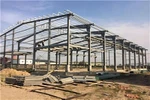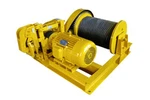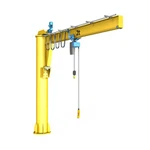Single Beam Traveling Gantry Cranes
Products Description
A single beam traveling gantry crane is a type of overhead lifting system designed for material handling in industrial, construction, and warehouse environments. It consists of a single horizontal beam (girder) supported by two legs that move on rails or wheels, allowing the crane to traverse along a defined path.
Key Features of Single Beam Traveling Gantry Cranes:
Single Girder Design
Uses one main beam (typically an I-beam or box girder) to support the hoist and trolley.
Lighter and more cost-effective compared to double girder cranes but has lower lifting capacity.
Traveling Mechanism
The entire gantry structure moves on rails or wheels (manual or motorized).
Can cover a large work area, making it ideal for workshops, storage yards, and assembly lines.
Hoist & Trolley System
An electric or manual hoist runs along the length of the beam.
Can be equipped with wire rope hoists or chain hoists depending on the load capacity.
Load Capacity
Typically ranges from 1 ton to 20 tons, though heavy-duty versions may go higher.
Suitable for light to medium-duty applications.
Mobility Options
Fixed Gantry: Stationary legs with a movable beam (common in workshops).
Traveling Gantry: Moves on rails or wheels (used in larger work areas).
Adjustable Width: Some models allow leg adjustment for varying workspace needs.
Power Options
Electric: Motorized travel and hoisting for heavy loads.
Manual: Hand-operated for lighter loads or budget applications.
Types of Traveling Gantry Cranes
| Type | Features | Best For |
|---|---|---|
| Single Girder | Lightweight, cost-effective, easy assembly. | Workshops, small factories, indoor use. |
| Double Girder | Higher capacity, more stable, longer spans. | Heavy industries, shipyards, steel plants. |
| Semi-Gantry Crane | One leg on a rail, the other on the ground. | Uneven workspaces, outdoor applications. |
| Rubber-Tired (Mobile) | No rails needed, moves freely on wheels. | Construction sites, temporary setups. |
| Adjustable Height | Telescopic legs for variable lifting heights. | Warehouses with changing storage needs. |
Place of Origin:Henan, China
Warranty:2 years
Weight (KG):60000 kg
Video outgoing-inspection:Provided
Machinery Test Report:Provided
Application:warehouses,factory and other place
Crane type:box type gantry crane
Travelling speed:20m/min
Lifting mechanism:Electric Hoist
Control method:Ground Control+ Remote Control (customized)
Working duty:A5
Working Temperature:-20~+40℃
Industrial voltage:380V50HZ3Phanse or other
Color:Customised
Customization:Accepted

Pictures & Components
A single beam traveling gantry crane is a type of overhead crane that moves on wheels along a rail system, typically used for lifting and transporting heavy loads in industrial settings. Here are its key components:
1. Main Girder (Single Beam)
The primary horizontal beam that spans the width of the crane, supporting the hoist and trolley.
Usually made of welded steel (box-type or I-beam design) for strength and rigidity.


2. End Trucks (Legs)
Vertical supports at each end of the girder that house the wheels for movement.
Can be fixed-height or adjustable to suit different workspace requirements.


3. Wheels & Rail System
Wheels: Mounted on the end trucks, allowing the crane to travel along the runway rails.
Runway Rails: Installed on the floor or elevated supports, guiding the crane's movement.

4. Hoist & Trolley
Hoist: The lifting mechanism (electric or manual) that raises/lowers loads (chain hoist or wire rope hoist).
Trolley: The assembly that moves the hoist along the length of the girder (manual or motorized).

5. Drive Mechanism (Travel Motors)
Electric motors (if powered) that move the crane along the rails.
May include gearboxes and brakes for controlled movement.

.
6. Controls
Pendant Control: A handheld device for operating the crane.
Radio Remote Control (optional): Wireless operation for better mobility.
Cab Control (less common in single-beam gantry cranes).

7. Bumpers & Stops
Rubber or spring-loaded bumpers at the ends to absorb impacts.
Rail stops to prevent over-travel.
8. Electrical System
Power supply (cable festoon or conductor bar system).
Limit switches for safe movement range.
9. Safety Features
Overload protection.
Emergency stop button.
Anti-collision systems (if multiple cranes operate in the same area).
10. Optional Accessories
Festoon System: Manages power and control cables.
Lighting: Work area illumination.
Crane Scale: For weighing loads during lifting.

Sketch

Main technical

Advantages
Single beam traveling gantry cranes are widely used in industrial and construction settings due to their simplicity, cost-effectiveness, and versatility. Here are some key advantages:
1. Cost-Effective
Lower initial cost compared to double beam gantry cranes.
Reduced maintenance expenses due to simpler structure.
2. Lightweight & Easy to Install
The single beam design makes the crane lighter, requiring less structural support.
Easier to transport and assemble, saving time and labor costs.
3. Space-Saving Design
Ideal for workshops with limited headroom since they have a compact structure.
Can be used in tight spaces where double beam cranes might not fit.
4. Versatility in Applications
Suitable for light to medium-duty lifting (typically up to 20 tons).
Commonly used in warehouses, workshops, construction sites, and shipping yards.
5. Smooth & Efficient Operation
Electric or manual trolley options for precise load positioning.
Can be customized with different hoists (chain hoist or wire rope hoist).
6. Mobility & Flexibility
Some models come with wheels or rails for easy movement.
Can be fixed or adjustable span to suit different workspace layouts.
7. Low Maintenance
Fewer components than double beam cranes, reducing wear and tear.
Simple mechanical structure makes inspections and repairs easier.
8. Customizable Options
Adjustable lifting height, span, and control systems (manual, pendant, or remote).
Can be designed for indoor or outdoor use with weather-resistant coatings.
Application:
Single-beam traveling gantry cranes are versatile lifting solutions commonly used in various industrial and construction applications. Their design features a single girder (beam) supported by legs that move on wheels or rails, allowing the crane to traverse along a predefined path. Here are some key applications:
1. Manufacturing & Warehousing
Assembly Lines: Moving raw materials, components, or finished products.
Loading/Unloading: Transporting goods in warehouses or production areas.
Maintenance Work: Lifting machinery or equipment for repairs.
2. Construction & Infrastructure
Material Handling: Transporting steel beams, concrete panels, or construction materials.
Bridge & Roadwork: Assisting in prefabricated segment installation.
Shipbuilding: Handling ship parts in dry docks or fabrication yards.
3. Logistics & Port Operations
Container Handling: Moving small to medium-sized containers in storage yards.
Freight Yards: Loading/unloading goods from trucks or railcars.
4. Metal & Mining Industry
Steel Mills: Handling coils, sheets, or metal bars.
Foundries: Transporting molten metal containers (with specialized safety features).
5. Power Plants & Heavy Industries
Turbine Maintenance: Lifting heavy generators or turbines for servicing.
Boiler & Pipe Installation: Moving large components in confined spaces.
6. Automotive & Aerospace
Component Handling: Transporting engines, fuselage parts, or heavy machinery.
Workshop Applications: Supporting assembly and maintenance tasks.
Crane production procedure
The production procedure for a single beam traveling gantry crane involves several key stages, from design and material procurement to assembly, testing, and final delivery. Below is a step-by-step outline of the typical manufacturing process:
1. Design & Engineering
Customer Requirements Analysis: Determine lifting capacity, span, lifting height, duty cycle, and operating environment.
Structural Design:
Design the main girder (single box or I-beam structure).
Design end carriages (legs/wheels) and runway beams.
Select hoist/trolley type (electric or manual).
Load & Stress Calculations: Ensure compliance with standards (ISO, FEM, DIN, or ASME).
Electrical & Control System Design: Choose motors, brakes, limit switches, and control panels.
2. Material Procurement
Steel Plates & Profiles: High-quality Q235B/Q345B steel for main girders and supports.
Mechanical Components: Wheels, axles, bearings, gears, and couplings.
Electrical Components: Motors, cables, control panels, and safety devices.
3. Fabrication of Main Components
A. Main Girder Fabrication
Cutting: CNC plasma/oxy-fuel cutting for precision.
Welding: Automated submerged arc welding (SAW) for strong seams.
Straightening & Inspection: Ensure proper camber (pre-bend) and check for defects (UT/RT testing).
B. End Carriages & Legs
Frame Assembly: Welded steel construction with reinforced bracing.
Wheel & Bearing Installation: Machined wheels for smooth travel.
C. Hoist & Trolley
Pre-assembled Hoist: Electric chain hoist or wire rope hoist.
Trolley Frame: Fabricated to accommodate hoist movement.
4. Surface Treatment & Painting
Shot Blasting: Removes rust and improves paint adhesion.
Primer & Paint: Anti-corrosion coatings (epoxy + polyurethane).
5. Assembly
Girder & End Carriage Joining: Bolt or weld the main beam to legs.
Hoist/Trolley Installation: Mounted on the girder.
Electrical Wiring: Connect motors, controls, and safety devices.
6. Testing & Quality Control
Dimensional Inspection: Verify span, height, and alignment.
Load Testing:
Static Load Test: 125% of SWL (Safe Working Load).
Dynamic Load Test: 110% of SWL with operational checks.
Functional Tests: Travel, lifting, braking, and limit switch verification.
7. Disassembly & Packaging
For Shipment: Crane may be disassembled into modules (girder, legs, hoist).
Protective Packaging: Waterproof wrapping for sea transport.
8. Installation & Commissioning (On-Site)
Runway Preparation: Ensure level rails or ground support.
Reassembly: Bolt components together.
Final Testing: Operational checks under load.
9. Documentation & Delivery
Manual & Certificates: Include load test reports, CE/ISO certifications.
Training: Operator and maintenance guidance.

Workshop view:
The company has installed an intelligent equipment management platform, and has installed 310 sets (sets) of handling and welding robots. After the completion of the plan, there will be more than 500 sets (sets), and the equipment networking rate will reach 95%. 32 welding lines have been put into use, 50 are planned to be installed, and the automation rate of the entire product line has reached 85%.





Hot Tags: single beam traveling gantry cranes, China single beam traveling gantry cranes manufacturers, suppliers, factory
You Might Also Like
Send Inquiry

























